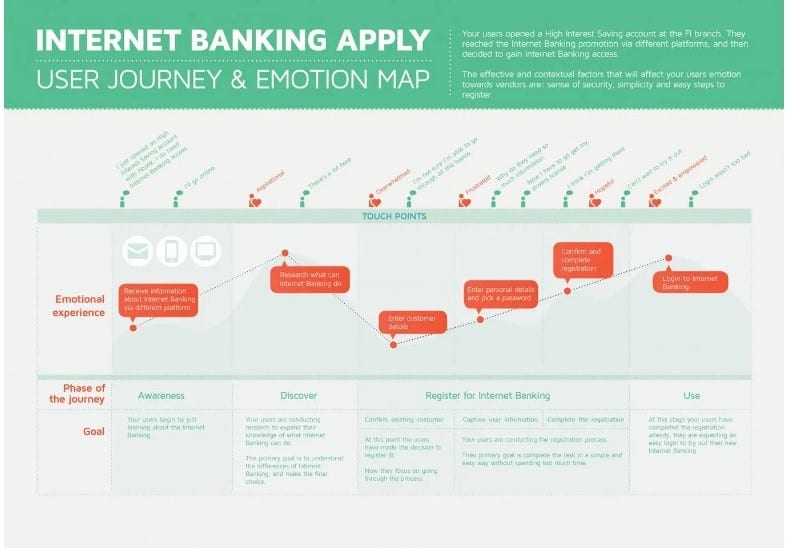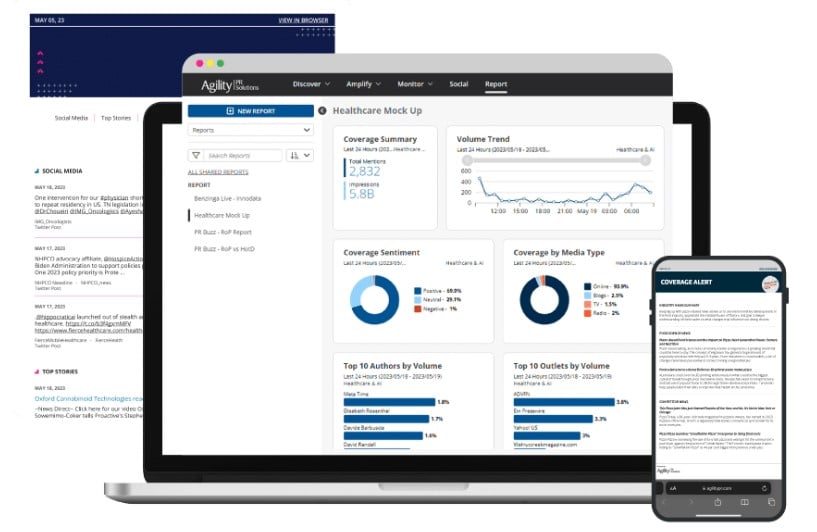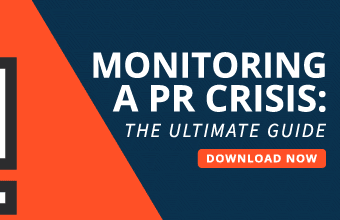Chaos hits when you least expect it.
One minute, your client’s brand is thriving. And the next, a social media storm or event puts everything at risk.
But here’s the thing …
Crises don’t have to break your client’s brand. Handling a crisis with integrity can showcase your client’s resilience, agility, and dedication to their customers.
Let’s take a closer look at eight crisis performance strategies you can use to help turn a chaotic situation into an opportunity for brand growth.
1) Be proactive by creating a crisis management plan
The worst time to create a crisis management plan is during a disaster. Instead, get ahead of it by creating a plan before something terrible happens.
Start by identifying potential threats to your client’s brand.
For example, these might be product malfunctions, social media backlash, or supply chain disruptions. Once you have a list, outline a step-by-step process for handling each situation.
Incident response plan templates can help you write instructions that guide teams through the chaos. Use them to ensure everyone knows their role, what actions to take, and how to communicate effectively.

For example, imagine a tech startup client suddenly experiencing a server crash, leaving its customers without service. With a crisis management plan, you’ll already understand how the team will handle the situation. This includes who will communicate with customers, what the CEO will say to the public, and how you’ll get the systems back up.
This also shows customers that the brand does its best to keep everything under control — despite the hiccup.
2) Act quickly, but know the full story first
Speed is pivotal in crisis management. But acting too quickly without understanding the whole picture can backfire.
Before making any public statements, gather all of the facts.
Let’s say a past employee accuses your client’s brand of unlawful termination on X, and the message spreads.
Take a moment to investigate. Talk to the team, review relevant interactions, and confirm the facts. Once you have all of the necessary information, act.
Release a statement on your client’s X profile that addresses the accusation with the truth. If the employee’s story is true, offer a sincere apology with a solution. If it’s not true, let the audience know the brand has looked into the situation and found the employee was legally fired. (And provide proof if possible.)
3) Partner with brand ambassadors for support
During a crisis, your client’s biggest fans can be their best defense.
Whether they’re influencers, long-time customers, or even employees — ambassadors can help steer the conversation in a positive direction.
Imagine a beauty brand facing backlash over a controversial product. Instead of going quiet, the brand reaches out to influencers and loyal customers who’ve had great experiences with their products. These ambassadors then create posts and videos showing off their favorite items and expressing their continued trust in the brand.

What happens next? Suddenly, there’s a wave of positive content online that starts to drown out the negative noise.
In other words, people trust satisfied buyers, so their voices have power.
To use this strategy, meet with your client to get a contact list of their biggest advocates. Then, reach out to the people on their list to see if they’d like to join your ambassador campaign. Let them know they’ll need to create and post user-generated content across their channels, and you will be able to reshare it.
You’ll also need to be honest with them if the crisis that occurred is especially controversial. In this case, they may not want to be associated with the brand’s public image, so make sure they have all of the facts.
4) Accept responsibility and provide a solution
No one expects perfection, but they do expect accountability. If your client’s brand has made a mistake, make sure the leadership team owns up to it.
There’s nothing worse than a company trying to dodge responsibility or shift blame. Customers see right through it.
Issue a public apology, offer compensation, or share how the brand will fix the issue.
For example, imagine your client’s e-commerce site experiences a data breach, and customer information is compromised.
You might have them:
- Share how their customers can protect their accounts in the meantime.
- Provide transparent updates as the situation unfolds.
- Explain what steps they’re taking to secure the data.
- Offer free credit monitoring to affected customers.
- Release a statement explaining what happened.
Accepting responsibility doesn’t make your client look weak — it shows that they’re human and committed to making things right.
5) Communicate with stakeholders and review your plan
When a crisis hits, keep all stakeholders in the loop. This includes employees, customers, partners, and investors.
Internally, your client’s employees are the first line of defense. Make sure they fully understand the situation and know how to respond to any inquiries. For example, if a retailer is dealing with shipping delays, customer service reps should be prepped with clear explanations, accurate timelines, and even potential discount offers to soothe frustrated buyers.
Externally, keeping investors, suppliers, and partners in the loop is just as important. Let them know how the crisis could impact them and what steps you’re taking to mitigate the risks. Communicating openly builds trust and keeps everyone aligned on the next steps.
Understanding how your client’s customers interact with their brand is also key. Use customer journey mapping to identify the critical touch points most impacted by the crisis and adapt your communication strategies accordingly.

Once the dust settles, review your crisis plan. What worked? What didn’t?
Learn from those moments to better prepare for the next challenge. Make it a habit to update your plan regularly so your team is always ready for whatever comes next.
6) Keep the audience updated on the resolution
It’s not enough to release a statement and then disappear. Your client’s audience wants to know how the resolution is progressing, and keeping them in the loop builds trust.
Let’s say you’re dealing with a product recall. After your initial statement, send regular updates (even if the situation is still developing). This proves your client is actively working to fix the issue.
For instance, provide a reason and a revised timeline if a delay occurs.
Here’s an example:
“After some unexpected complications, we’ve decided to extend the product recall by two weeks. Your safety and well-being is our top priority. We appreciate your patience as we work to make sure everything gets back on track.”
This can help reassure the audience and prevent more frustration.
7) Give the audience a chance to engage
Communication shouldn’t be a one-way street during a crisis. Give your client’s audience the opportunity to engage with the brand directly—whether that’s via social media, email, or a live video call.
Let’s take a company facing a product recall as an example. After announcing the recall, invite customers to ask questions or raise concerns.
Make sure the customer service team is ready to respond promptly and compassionately.
Inviting the audience to voice their concerns helps the brand show that it values their input and is committed to resolving the issue.
8) Use media monitoring tools to get ahead of negative brand mentions
In a crisis, the conversation around your client’s brand can spiral quickly. By the time you’re aware of a negative trend, it might already be too late.
That’s why media monitoring tools are invaluable. Use them to track online brand mentions in real time across social media, blogs, and news outlets.

For instance, if a restaurant chain client experiences a food quality complaint, media monitoring can alert you when negative reviews or complaints pop up online.
Use this opportunity to jump into action before the negative sentiment spreads.
Address every comment, especially any that shares negative feedback. Make sure to express a sincere apology and provide a solution (like a coupon for a future purchase or a free dinner). You can also have the restaurant manager reach out to them personally via email or phone.
Be sure to engage with positive commenters and push their comments up the feed. This can help reframe your client’s brand in a more positive light without ignoring unhappy customers.
Wrap up
Crisis management strategies give brands a chance to show their true integrity and values during difficult times.
When a brand does the right thing during a crisis, it can help deepen trust, strengthen relationships, and even open the door to new business opportunities.
For good measure, here’s a quick recap of the strategies we shared in this guide:
- Be proactive by creating a crisis management plan. Prepare for potential issues before they happen to respond confidently.
- Act quickly, but gather the facts first. Know the whole story and then act as soon as possible.
- Partner with brand ambassadors. Lean on your loyal supporters to help manage the narrative.
- Accept responsibility and provide a solution. Own your mistakes and offer a clear solution and path forward.
- Communicate with stakeholders and review your plan. Keep everyone in the loop, and continuously refine your crisis strategy.
- Keep the audience updated. Make sure customers feel informed and reassured.
- Give the audience a chance to engage. Let customers voice their concerns and respond with empathy.
- Use media monitoring tools. Stay ahead of negative sentiment by tracking mentions in real time.
For more crisis management insights, be sure to check out the Agility PR Solutions Resource Center.
And if you’re looking to connect with journalists, get coverage, or monitor media mentions, check out our AI-powered PR tools and services here.
To your success!








